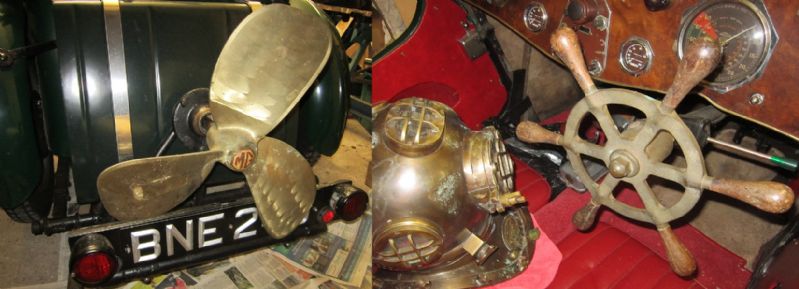| Author |
 Topic Topic  |
|
|
coracle
United Kingdom
2270 Posts |
 Posted - 29/09/2024 : 17:56:01 Posted - 29/09/2024 : 17:56:01

|
Some of you will be aware of the addition I made during a previous spell of damp weather.
I have made some further additions and precautions:

|
|
|
Westbury
United Kingdom
2255 Posts |
 Posted - 29/09/2024 : 18:40:10 Posted - 29/09/2024 : 18:40:10

|
Will your capacity for imagination ever end, Nigel? Personally, I am suitably impressed!
Cheers,
Chris |
 |
|
|
Oz34
United Kingdom
2697 Posts |
 Posted - 29/09/2024 : 18:56:21 Posted - 29/09/2024 : 18:56:21

|
I fear Nigel that without a couple of pontoons as our Transatlantic friends would call them, all the propeller will do is hasten your car's descent into the depths while the wheel may give you some small choice as to her final resting place.
Dave |
Edited by - Oz34 on 29/09/2024 18:56:57 |
 |
|
|
Cooperman
United Kingdom
792 Posts |
 Posted - 30/09/2024 : 15:11:52 Posted - 30/09/2024 : 15:11:52

|
You will need some sort of snorkel for both the exhaust and the carburettor.
John Cooper M 628 |
 |
|
|
DanPA
USA
179 Posts |
 Posted - 30/09/2024 : 16:02:54 Posted - 30/09/2024 : 16:02:54

|
Is the MG emblem on the propeller original? What was the finish originally on the steering wheel?
Lovely! Thanks,
Dan
Daniel Shockey |
 |
|
|
coracle
United Kingdom
2270 Posts |
 Posted - 06/10/2024 : 16:45:33 Posted - 06/10/2024 : 16:45:33

|
The MG emblem on the propeller is original, but not to the propeller.
The wheel is cast bronze but could do with a clean.
The snorkel arrangements for the inlet and exhaust double up with the feed and return plumbing to the diving helmet. Breathers for the back axle, gearbox and engine proved challenging.
Further developments perhaps will concentrate on foils to lift the car clear of the water mitigating some of the drawbacks.
I fear parking might be difficult. |
 |
|
|
KevinA
New Zealand
723 Posts |
 Posted - 21/10/2024 : 03:58:25 Posted - 21/10/2024 : 03:58:25

|
| The recent thread on a different topic has got me wondering if any of these modifications use Whitworth threads. If so, what spanners do you use? |
 |
|
|
coracle
United Kingdom
2270 Posts |
 Posted - 21/10/2024 : 13:27:06 Posted - 21/10/2024 : 13:27:06

|
Yes, the steering column thread is Whitworth; see the inset in the photo below.
Contrary to popular opinion, the Whitworth thread is described as coarse, not because of the thread pitch but for two other peculiarities.
1) Due to the reduced minor diameter in relation to its major, it is more easily sheared,
2) The confusion in choosing the correct spanner size as outlined in Simon's thread.
These peculiarities lead to the extensive utilisation of adjectives that are often classed "coarse;" hence the term "a coarse thread."
In the 1970's there was a useful publication "Butterfields Loose Tools;" a compendium of the statutes around various tax allowances amongst other things. Therein was a particularly gripping section comparing the "Monkey wrench." with the "Stillson wrench" (Not to be confused with the "Stilton wench" a 18th century artisan cheese maker.)
Close study of that volume lead me to consider both Monkey and Stillson wrenches. Both come in useful size ranges, defined by their length. The Monkey can be difficult in tight spaces and the Stillson can shred your nuts. In the example photo a small selection of Stillsons illustrates the continuoius range covered.
When the chips are down you can't beat the 36" Stillson and/or an 18lb "Birmingham screwdriver."

P.S. There is also a lesser known "Stilton wrench" that in early years was a specialist tool used for turning stiltons to aid even maturation. |
 |
|
| |
 Topic Topic  |
|

